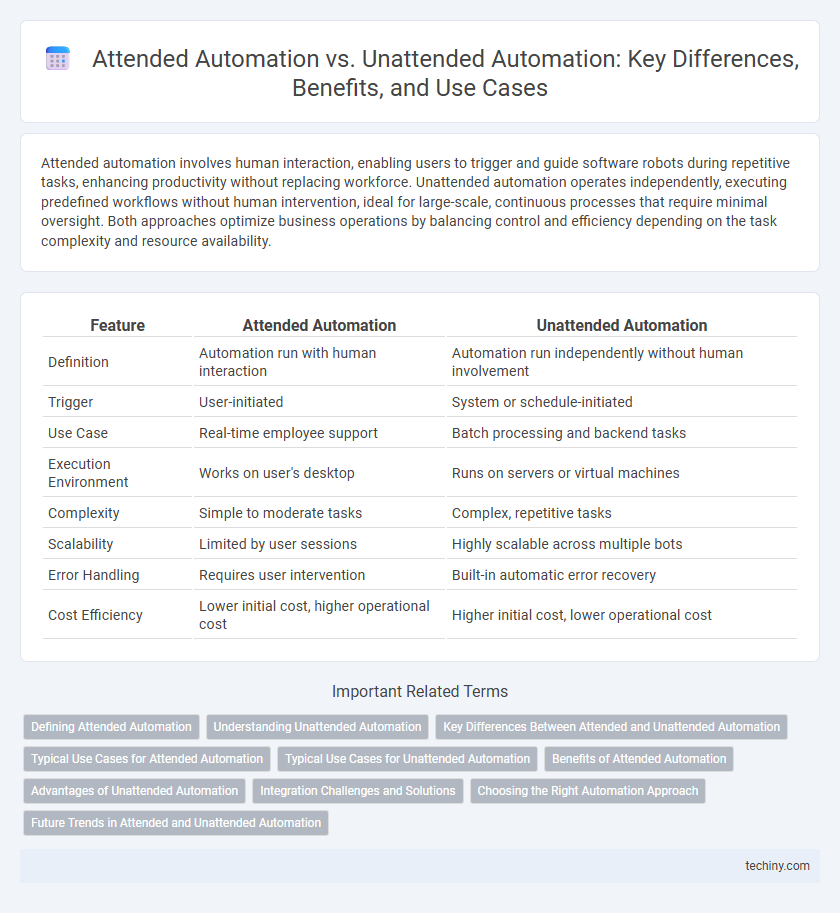Attended automation involves human interaction, enabling users to trigger and guide software robots during repetitive tasks, enhancing productivity without replacing workforce. Unattended automation operates independently, executing predefined workflows without human intervention, ideal for large-scale, continuous processes that require minimal oversight. Both approaches optimize business operations by balancing control and efficiency depending on the task complexity and resource availability.
Table of Comparison
| Feature | Attended Automation | Unattended Automation |
|---|---|---|
| Definition | Automation run with human interaction | Automation run independently without human involvement |
| Trigger | User-initiated | System or schedule-initiated |
| Use Case | Real-time employee support | Batch processing and backend tasks |
| Execution Environment | Works on user's desktop | Runs on servers or virtual machines |
| Complexity | Simple to moderate tasks | Complex, repetitive tasks |
| Scalability | Limited by user sessions | Highly scalable across multiple bots |
| Error Handling | Requires user intervention | Built-in automatic error recovery |
| Cost Efficiency | Lower initial cost, higher operational cost | Higher initial cost, lower operational cost |
Defining Attended Automation
Attended automation involves robotic process automation (RPA) tools that assist human employees by performing tasks in real-time during user interaction, enhancing efficiency and reducing errors in workflows. It operates alongside users on their desktops to handle repetitive, rule-based tasks such as data entry, customer service, and transaction processing. This type of automation is ideal for scenarios requiring human judgment combined with automated speed and accuracy.
Understanding Unattended Automation
Unattended automation operates without human intervention, executing predefined tasks automatically in background systems 24/7 to enhance efficiency and reduce operational costs. This form of automation is ideal for repetitive, rule-based processes such as data extraction, report generation, and batch processing across various industries. Implementing unattended automation boosts scalability and accuracy, while minimizing the risks of human error inherent in manual workflows.
Key Differences Between Attended and Unattended Automation
Attended automation involves human intervention during process execution, enabling real-time decision-making and exception handling, whereas unattended automation operates independently without human input, handling tasks autonomously. Attended automation is ideal for front-office activities requiring immediate user support, while unattended automation suits back-office processes with high volume and repetitive tasks. Key differences include execution environment, error management approach, and integration complexity with existing systems.
Typical Use Cases for Attended Automation
Attended automation is commonly used in customer service, where it assists representatives by automating repetitive tasks while allowing human intervention for complex decision-making. It is ideal for front-office processes such as data entry, real-time data validation, and guiding employees through workflows. Typical cases also include IT support and helpdesk operations, enhancing productivity by streamlining routine activities without removing the human element.
Typical Use Cases for Unattended Automation
Unattended automation excels in handling high-volume, repetitive tasks such as invoice processing, data extraction, and batch report generation without human intervention. It is ideal for 24/7 operations like IT system monitoring, automated backups, and order fulfillment in e-commerce platforms. Enterprises benefit from unattended automation by significantly reducing manual workload, accelerating process execution, and ensuring consistent accuracy across scalable workflows.
Benefits of Attended Automation
Attended Automation enhances workforce productivity by enabling employees to execute repetitive tasks swiftly while maintaining human oversight, thereby reducing errors and improving accuracy. It offers real-time assistance by integrating seamlessly with user workflows, boosting operational efficiency and customer satisfaction. This approach supports dynamic decision-making, empowering staff to focus on high-value activities and increase overall business agility.
Advantages of Unattended Automation
Unattended automation offers significant advantages such as continuous 24/7 operation without human intervention, leading to increased productivity and reduced labor costs. It enhances process consistency and accuracy by minimizing human errors in repetitive tasks. This automation type is ideal for large-scale, high-volume workflows, ensuring faster execution and scalability across complex enterprise systems.
Integration Challenges and Solutions
Integration challenges in attended automation often involve ensuring seamless collaboration between human operators and bots within existing workflows, requiring real-time data exchange and user interface synchronization. Unattended automation faces obstacles related to connecting disparate systems without manual intervention, demanding robust API integrations and error-handling mechanisms. Solutions include adopting middleware platforms that standardize data communication, leveraging AI-driven orchestration tools for dynamic task management, and implementing scalable, secure connectors to bridge legacy and modern applications efficiently.
Choosing the Right Automation Approach
Choosing the right automation approach depends on the level of human intervention required during the process. Attended automation is ideal for tasks needing real-time user input and decision-making, enhancing productivity in customer service and desktop support scenarios. Unattended automation suits repetitive, rule-based processes that operate independently, significantly reducing operational costs and error rates in back-office workflows.
Future Trends in Attended and Unattended Automation
Future trends in attended automation emphasize enhanced human-robot collaboration through AI-driven interfaces that improve real-time decision-making and user experience. Unattended automation is advancing with increased integration of machine learning algorithms for predictive maintenance and autonomous process optimization. The convergence of attended and unattended automation platforms is driving smarter hybrid workflows, maximizing efficiency across enterprise operations.
Attended Automation vs Unattended Automation Infographic

 techiny.com
techiny.com